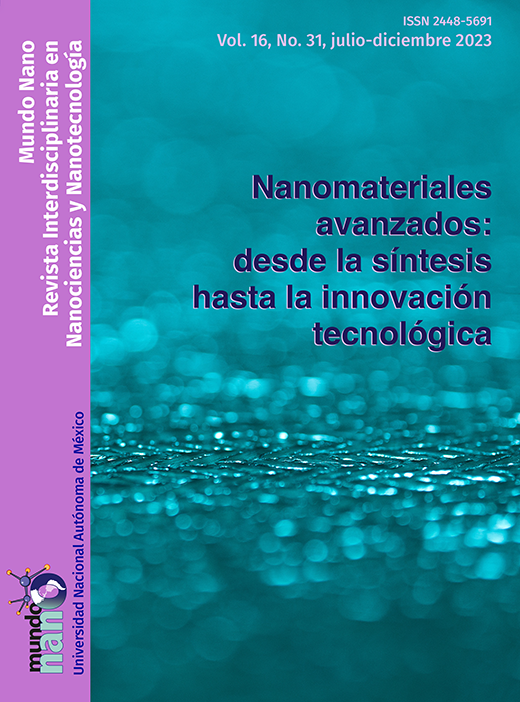Nanopartículas metálicas: una alternativa para combatir la resistencia de especies causantes de la candidiasis
Contenido principal del artículo
Resumen
La candidiasis es provocada por diferentes especies del género Candida, siendo C. albicans la más común en los aislados clínicos a nivel mundial. Esta enfermedad es un problema para el sector salud, debido a la multirresistencia que algunas especies de Candida presentan a los antifúngicos tradicionalmente utilizados para controlar la enfermedad. Tal es el caso de C. glabrata y recientemente C. auris, las cuales son resistentes a los azoles, las equinocandinas y a los polienos; por lo cual, la búsqueda de nuevos antifúngicos es una prioridad. La nanotecnología ofrece nuevas alternativas, como el uso de las nanopartículas (NPs) metálicas, en particular, las de plata y cobre han mostrado ser eficientes para la inhibición de C. albicans. En este trabajo se presentan los estudios más relevantes que han evaluado el efecto de las NPs metálicas en especies del género Candida, así como los resultados más prometedores.
Descargas
Detalles del artículo

Mundo Nano. Revista Interdisciplinaria en Nanociencias y Nanotecnología, editada por la Universidad Nacional Autónoma de México, se distribuye bajo una Licencia Creative Commons Atribución-NoComercial 4.0 Internacional.
Basada en una obra en http://www.mundonano.unam.mx.
Citas
Abdallah, B. M., y Ali, E. M. (2021). Green synthesis of silver nanoparticles using the Lotus lalambensis aqueous leaf extract and their anti-candidal activity against oral candidiasis. ACS Omega, 6(12): 8151-8162. https://doi.org/10.1021/acsomega.0c06009. DOI: https://doi.org/10.1021/acsomega.0c06009
Achudhan, D., Vijayakumar, S., Malaikozhundan, B., Divya, M., Jothirajan, M., Subbian, K., González-Sánchez, Z. I., Mahboob, S., Al-Ghanim, K. A. y Vaseeharan, B. (2020). The antibacterial, antibiofilm, antifogging and mosquitocidal activities of titanium dioxide (TiO2) nanoparticles green-synthesized using multiple plants extracts. Journal of Environmental Chemical Engineering, 8(6), 104521. https://doi.org/10.1016/j.jece.2020.104521. DOI: https://doi.org/10.1016/j.jece.2020.104521
Arendrup, M. C., Patterson, T. F. (2017). Multidrug-resistant Candida: Epidemiology, molecular mechanisms, and treatment. J. Infect. Dis., 216: S445-S451. https://doi.org/10.1093/infdis/jix131. DOI: https://doi.org/10.1093/infdis/jix131
Biasoli, M. S., Tosello, M. E., Luque, A. G. y Magaró, H. M. (2010). Adherence, colonization and dissemination of Candida dubliniensis and other Candida species. Medical Mycology, 48(2): 291-297. https://doi.org/10.3109/13693780903114942. DOI: https://doi.org/10.3109/13693780903114942
Castro-Longoria, E., Garibo-Ruiz, D., Martínez-Castro, S. (2017). Myconanotechnology to treat infectious diseases: a perspective. in fungal nanotechnology. Berlin/Heidelberg, Germany: Springer, 235-261. DOI: https://doi.org/10.1007/978-3-319-68424-6_12
Cheong, Y.-K., Arce, M. P., Benito, A., Chen, D., Luengo Crisóstomo, N., Kerai, L. V, Rodríguez, G., Valverde, J. L., Vadalia, M., Cerpa-Naranjo, A. y Ren, G. (2020). Synergistic antifungal study of PEGylated graphene oxides and copper nanoparticles against Candida albicans. Nanomaterials, 10(5). https://doi.org/10.3390/nano10050819. DOI: https://doi.org/10.3390/nano10050819
Chowdhary, A., Sharma, C., Meis, J. F. (2017). Candida auris: A rapidly emerging cause of hospital-acquired multidrug-resistant fungal infections globally. PLoS Pathog, 13(5): e1006290. https://doi.org/10.1371/journal.ppat.1006290. DOI: https://doi.org/10.1371/journal.ppat.1006290
Dashtizadeh, Z., Jookar Kashi, F., y Ashrafi, M. (2021). Phytosynthesis of copper nanoparticles using Prunus mahaleb L. and its biological activity. Materials Today Communications, 27(mayo). https://doi.org/10.1016/j.mtcomm.2021.102456. DOI: https://doi.org/10.1016/j.mtcomm.2021.102456
Din, M. I. y Rehan, R. (2017). Synthesis, characterization, and applications of copper nanoparticles. Analytical Letters, 50(1): 50-62. https://doi.org/10.1080/00032719.2016.1172081. DOI: https://doi.org/10.1080/00032719.2016.1172081
Elbahnasawy, M. A., Shehabeldine, A. M., Khattab, A. M., Amin, B. H. y Hashem, A. H. (2021). Green biosynthesis of silver nanoparticles using novel endophytic Rothia endophytica: Characterization and anticandidal activity. Journal of Drug Delivery Science and Technology, 62, 102401. https://doi.org/10.1016/j.jddst.2021.102401. DOI: https://doi.org/10.1016/j.jddst.2021.102401
El-Sherbiny, G. M., Lila, M. K., Shetaia, Y. M., Elswify, M. M. y Mohamed, S. S. (2020). Antimicrobial activity of biosynthesised silver nanoparticles against multidrug-resistant microbes isolated from cancer patients with bacteraemia and candidaemia. Indian Journal of Medical Microbiology, 38(3-4): 371-378. https://doi.org/10.4103/ijmm.IJMM_20_299. DOI: https://doi.org/10.4103/ijmm.IJMM_20_299
García-Marín, L. E., Juárez-Moreno, K., Vilchis-Néstor, A. R. y Castro-Longoria, E. (2022). Highly antifungal activity of biosynthesized copper oxide nanoparticles against Candida albicans. Nanomaterials, 12(21). https://doi.org/10.3390/nano12213856. DOI: https://doi.org/10.3390/nano12213856
Garnacho-Montero, J., Díaz-Martín, A., De Piappón, M. R.-P. y García-Cabrera, E. (2012). Infección fúngica invasiva en los pacientes ingresados en las áreas de críticos. Enfermedades Infecciosas y Microbiologia Clínica, 30(6): 338–343. https://doi.org/10.1016/j.eimc.2012.02.011. DOI: https://doi.org/10.1016/j.eimc.2012.02.011
Ghosh Chaudhuri, R. y Paria, S. (2012). Core/shell nanoparticles: classes, properties, synthesis mechanisms, characterization, and applications. Chemical Reviews, 112(4), 2373-2433. https://doi.org/10.1021/cr100449n. DOI: https://doi.org/10.1021/cr100449n
Guzman, M., Dille, J., y Godet, S. (2012). Synthesis and antibacterial activity of silver nanoparticles against gram-positive and gram-negative bacteria. Nanomedicine: Nanotechnology, Biology, and Medicine, 8(1): 37-45. https://doi.org/10.1016/j.nano.2011.05.007. DOI: https://doi.org/10.1016/j.nano.2011.05.007
Hwang, I., Lee, J., Hwang, J. H., Kim, K.-J. y Lee, D. G. (2012). Silver nanoparticles induce apoptotic cell death in Candida albicans through the increase of hydroxyl radicals. The FEBS Journal, 279(7): 1327-1338. https://doi.org/10.1111/j.1742-4658.2012.08527.x. DOI: https://doi.org/10.1111/j.1742-4658.2012.08527.x
Ingle, A. P., Duran, N. Rai, M. (2014). Bioactivity, mechanism of action, and cytotoxicity of copper-based nanoparticles: A review. Appl. Microbiol. Biotechnol., 98: 1001-1009. https://doi.org/10.1007/s00253-013-5422-8. DOI: https://doi.org/10.1007/s00253-013-5422-8
Ijaz, I., Gilani, E., Nazir, A. y Bukhari, A. (2020). Detail review on chemical, physical and green synthesis, classification, characterizations and applications of nanoparticles. Green Chemistry Letters and Reviews, 13(3): 59-81. https://doi.org/10.1080/17518253.2020.1802517. DOI: https://doi.org/10.1080/17518253.2020.1802517
Karkowska-Kuleta, J., Kulig, K., Karnas, E., Zuba-Surma, Woznicka, Olga, Pyza, E., Kuleta, P., Osyezka, A., Kozik, MR., Kozik, A. (2020). Characteristics of extracellular vesicles released by the pathogenic yeast-like fungi Candida glabrata, Candida parapsilosis and Candida tropicalis. Cells, 9(7): 1722 https://doi.org/10.3390/cells9071722. DOI: https://doi.org/10.3390/cells9071722
Khaled, Y. y Pahuja, B. K. (2019). Identifying the different kinds of oral Candida species in denture wearing patients. EC Dental Science, 18(7): 1428-1434.
Lakshminarayanan, R., Ye, E., Young, D. J., Li, Z. y Loh, X. J. (2018). Recent advances in the development of antimicrobial nanoparticles for combating resistant pathogens. Advanced Healthcare Materials, 7(13), 1701400. https://doi.org/10.1002/adhm.201701400. DOI: https://doi.org/10.1002/adhm.201701400
Lazo, V., Hernández, G. y Méndez, R. (2018). Candidiasis sistémica en pacientes críticos, factores predictores de riesgo. Horizonte Médico (Lima), 18(1): 75-85. http://dx.doi.org/10.24265/horizmed.2018.v18n1.11. DOI: https://doi.org/10.24265/horizmed.2018.v18n1.11
Lee, B., Lee, M. J., Yun, S. J., Kim, K., Choi, I.-H. y Park, S. (2019). Silver nanoparticles induce reactive oxygen species-mediated cell cycle delay and synergistic cytotoxicity with 3-bromopyruvate in Candida albicans, but not in Saccharomyces cerevisiae. International Journal of Nanomedicine, 14, 4801. https://doi.org/10.2147/IJN.S205736. eCollection 2019. DOI: https://doi.org/10.2147/IJN.S205736
Lone, S. A. y Ahmad, A. (2019). Candida auris — The growing menace to global health. Mycoses, 62(8): 620-637. https://doi.org/10.1111/myc.12904. DOI: https://doi.org/10.1111/myc.12904
Martínez, A., Apip, C., Meléndrez, M. F., Domínguez, M., Sánchez‐Sanhueza, G., Marzialetti, T. y Catalán, A. (2021). Dual antifungal activity against Candida albicans of copper metallic nanostructures and hierarchical copper oxide marigold‐like nanostructures grown in situ in the culture medium. Journal of Applied Microbiology, 130(6): 1883-1892. https://doi.org/10.1111/jam.14859. DOI: https://doi.org/10.1111/jam.14859
Martínez-Andrade, J. M., Avalos-Borja, M., Vilchis-Néstor, A. R., Sánchez-Vargas, L. O. y Castro-Longoria, E. (2018). Dual function of EDTA with silver nanoparticles for root canal treatment–A novel modification. PLoS ONE, 13(1): 1-19. https://doi.org/10.1371/journal.pone.0190866. DOI: https://doi.org/10.1371/journal.pone.0190866
Mauricio, M. D., Marchio, P., Valles, S. L., Aldasoro, M., Herance, J. R., Rocha, M., Vila, J. M., y Víctor, V. M. (2018). Review article nanoparticles in medicine : a focus on vascular oxidative stress. https://doi.org/10.1155/2018/6231482. DOI: https://doi.org/10.1155/2018/6231482
McCarty, T. P., White, C. M. y Pappas, P. G. (2021). Candidemia and invasive candidiasis. Infectious Disease Clinics of North America, 35(2): 389-413. https://doi.org/10.1016/j.idc.2021.03.007. DOI: https://doi.org/10.1016/j.idc.2021.03.007
McCullough, M. J., Ross, B. C. y Reade, P. C. (1996). Candida albicans: a review of its history, taxonomy, epidemiology, virulence attributes, and methods of strain differentiation. International Journal of Oral and Maxillofacial Surgery, 25(2): 136-144. https://doi.org/10.1016/S0901-5027(96)80060-9. DOI: https://doi.org/10.1016/S0901-5027(96)80060-9
Mixão, V. de P. (2020). Hybridization in Candida yeast pathogens. September 2019. https://widgets.ebscohost.com/prod/customerspecific/ns000545/customproxy.php?url=https://search.ebscohost.com/login.aspx?direct=true&db=edstdx&AN=edstdx.10803.670103&%0Alang=pt-pt&site=eds-live&scope=site.
Mohammadi, M., Shahisaraee, S. A., Tavajjohi, A., Pournoori, N., Muhammadnejad, S., Mohammadi, S. R., Poursalehi, R. y Delavari H, H. (2019). Green synthesis of silver nanoparticles using Zingiber officinale and Thymus vulgaris extracts: characterization, cell cytotoxicity, and its antifungal activity against Candida albicans in comparison to fluconazole. IET Nanobiotechnology, 13(2): 114-119. https://doi.org/10.1049/iet-nbt.2018.5146. DOI: https://doi.org/10.1049/iet-nbt.2018.5146
Mudiar, R. y Kelkar-Mane, V. (2020). Original research article (experimental): Targeting fungal menace through copper nanoparticles and Tamrajal. Journal of Ayurveda and Integrative Medicine, 11(3): 316-321. https://doi.org/10.1016/j.jaim.2018.02.134. DOI: https://doi.org/10.1016/j.jaim.2018.02.134
Murillo-Rábago, E. I., Vilchis-Néstor, A. R., Juárez-Moreno, K., García-Marin, L. E., Quester, K., Castro-Longoria, E. (2022). Optimized synthesis of small and stable silver nanoparticles using intracellular and extracellular components of fungi: an alternative for bacterial inhibition. Antibiotics, 11(6). DOI: https://doi.org/10.3390/antibiotics11060800
Niknejad, F., Nabili, M., Ghazvini, R. D. y Moazeni, M. (2015). Green synthesis of silver nanoparticles: advantages of the yeast Saccharomyces cerevisiae model. Current Medical Mycology, 1(3): 17. https://doi.org/10.18869/acadpub.cmm.1.3.17. DOI: https://doi.org/10.18869/acadpub.cmm.1.3.17
Padmavathi, A. R., Das, A., Priya, A., Sushmitha, T. J., Pandian, S. K. y Toleti, S. R. (2020). Impediment to growth and yeast-to-hyphae transition in Candida albicans by copper oxide nanoparticles. Biofouling, 36(1): 56-72. https://doi.org/10.1080/08927014.2020.1715371. DOI: https://doi.org/10.1080/08927014.2020.1715371
Pappas, P. G., Kauffman, C. A., Andes, D. R., Clancy, C. J., Marr, K. A., Ostrosky-zeichner, L., Reboli, A. C., Schuster, M. G., Vázquez, J. A. y Walsh, T. J. (n.d.), Zaoutis T. E., Sobel, J. D. (2016). Executive summary: clinical practice guideline for the management of candidiasis: 2016. Update by the Infectious Diseases Society of America. Clin. Infect. Dis, 62(4): 409-417. DOI: https://doi.org/10.1093/cid/civ1194
Pappas, P. G., Lionakis, M. S., Arendrup, M. C., Ostrosky-Zeichner, L. y Kullberg, B. J. (2018). Invasive candidiasis. Nature Reviews Disease Primers, 4(1): 1-20. https://doi.org/10.1038/nrdp.2018.26. DOI: https://doi.org/10.1038/nrdp.2018.26
Pastrana-Gómez, C. A., Almonacid-Urrego, C. C., Velasco-Montejo, B. E., Mendieta-Zerón, H. y Cuevas-Yáñez, E. (2020). Antimycotic sensitivity evaluation against Candida ATCC species of 1,2,3-triazoles derived from 5-chloro-2(2,4-dichlorophenoxy)phenol. Medicinal Chemistry Research, 29(3): 417-425. https://doi.org/10.1007/s00044-019-02490-7. DOI: https://doi.org/10.1007/s00044-019-02490-7
Pfaller, M. A. y Diekema, D. (2007). Epidemiology of invasive candidiasis: a persistent public health problem. Clinical Microbiology Reviews, 20(1): 133-163. DOI: https://doi.org/10.1128/CMR.00029-06
Pillai, A. M., Sivasankarapillai, V. S., Rahdar, A., Joseph, J., Sadeghfar, F., Anuf A, R., Rajesh, K. y Kyzas, G. Z. (2020). Green synthesis and characterization of zinc oxide nanoparticles with antibacterial and antifungal activity. Journal of Molecular Structure, 1211, 128107. https://doi.org/10.1016/j.molstruc.2020.128107. DOI: https://doi.org/10.1016/j.molstruc.2020.128107
Silva, S., Negri, M., Henriques, M., Oliveira, R., Williams, D. W. y Azeredo, J. (2012). Candida glabrata, Candida parapsilosis and Candida tropicalis: biology, epidemiology, pathogenicity and antifungal resistance. FEMS Microbiology Reviews, 36(2): 288-305. https://doi.org/10.1111/j.1574-6976.2011.00278.x. DOI: https://doi.org/10.1111/j.1574-6976.2011.00278.x
Talapko, J., Juzbašić, M., Matijević, T., Pustijanac, E., Bekić, S., Kotris, I., y Škrlec, I. (2021). Candida albicans-the virulence factors and clinical manifestations of infection. Journal of Fungi, 7(2): 1-19. https://doi.org/10.3390/jof7020079. DOI: https://doi.org/10.3390/jof7020079
Tang, Y., Fang, L., Xu, C., y Zhang, Q. (2017). Antibiotic resistance trends and mechanisms in the foodborne pathogen. Campylobacter. Animal Health Research Reviews, 18(2): 87-98. https://doi.org/10.1017/S1466252317000135. DOI: https://doi.org/10.1017/S1466252317000135
Tahvilian, R., Mahdi, M. y Falahi, H. (2019). Green synthesis and chemical characterization of copper nanoparticles using Allium saralicum leaves and assessment of their cytotoxicity, antioxidant, antimicrobial and cutaneous wound healing properties. Applied Organometallic Chemistry, 33(12): 1-16. https://doi.org/10.1002/aoc.5234. DOI: https://doi.org/10.1002/aoc.5234
Vázquez-Muñoz, R., Avalos-Borja, M. y Castro-Longoria, E. (2014). Ultrastructural analysis of Candida albicans when exposed to silver nanoparticles. PLOS ONE, 9(10): e108876. https://doi.org/10.1371/journal.pone.0108876. DOI: https://doi.org/10.1371/journal.pone.0108876
Yassin, M. T., Mostafa, A. A. F., Al-Askar, A. A. y Al-Otibi, F. O. (2022). Synergistic antifungal efficiency of biogenic silver nanoparticles with itraconazole against multidrug-resistant Candida strains. Crystals, 12(6): 816. https://doi.org/10.3390/cryst12060816. DOI: https://doi.org/10.3390/cryst12060816





